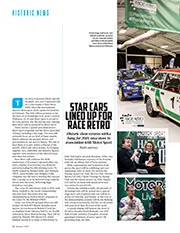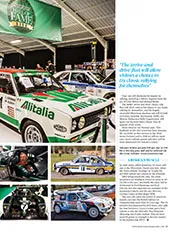

Star cars line up for Race Retro
Historic show returns for 2018, again in association with Motor Sport The story of ground effects and the dramatic race cars it spawned will be a core theme of Race…
An Italian Champion
Details of the 2!-2-litre Maserati.
THE performance of the 2i-litre Maserati in the great races of the 1930 season has been sufficiently striking to make this machine of particular interest to all followers of automobile sport. Its successes in its native country have included the Grand Prix of Rome, with Arcangeli as its driver, while Varzi has brought one of these cars home first in the Coppa Acerbo, the Grand Prix of Monza, and, outside Italy, in the San Sebastian Grand Prix. What renders the car even more interesting, however, is that Maserati, following the excellent lead set by Bugatti, has decided to make his successful racing model on a commercial scale, and machines identical with those which have scored such striking successes in last year’s classic races, are now available to the general public. Several English sporting motorists have already acquired cars of this type for use in the big events of next season, and it is probable that others who have not yet decided on a new mount will find in the Maserati something which comes very near to their ideal of a motor car for serious competition work. It may thus be of considerable interest to readers of MOTOR SPORT if we give a fairly detailed description of this car. In the first place, even if the Maserati has shown itself during the past season superior on so many occasions to the best of the stern competition it has had to encounter, this result has not been attained by any revolutionary break-away from general racing practice. Maserati has, in fact, preferred to build his car along the
well-tried lines which were followed in the Grand Prix races of 1923-7 by such firms as riat, Alfa-Romeo and Delage. In several instances even the Bologna constructor has seemed to prefer to follow rather more classic practice than do some of his competitors, and count on attaining superiority by very careful manufacture. As an example, the big ends of this engine’s connecting rods are fitted with plain white metal bearings, but no lubrication difficulties have been encountered, although naturally the Maserati’s maximum revs, are as high as those of other racing engines of similar type. If the following description of the car therefore does not seem to disclose anything very important in the way of technical novelties, it must not be supposed that for that reason the machine must be debarred from consideration as one of the potentially most successful in competition with really worthy rivals.
The engine is a straight-eight, the cylinders having a bore and stroke of 65 x 94 mm., and thus a total capacity of just ‘under 2,500 c.c. The compression ratio is not particularly high for a racing engine amounting to 7 : 1 or 8 : 1. The head is detachable and hemispherical in shape and carries two valves per cylinder. The valves are operated by two overhead camshafts, which take their drive from the crankshaft by means of a train of nine steel pinions enclosed in a housing at the back of the cylinder block. The valves themselves are made of a special steel, and, there being only two per cylinder, have the fairly
large diameter in relation to that of the head of 1.41 ins. The inlet valve has a concave head in order to obtain lightness, but the head of the exhaust valve is flat as the considerable heat to which it is subjected might otherwise lead to distortion and imperfect seating, the seat itself being at 450. The valves are closed by two concentric springs, having a combined tension of about 143 lbs., and are mounted at 45° to the vertical, the angle between them thus being a right-angle. The timing is arranged so that the inlet valve opens 15° early and closes 450 late ; while the exhaust has a lead of 45° and closes 20° after top dead centre. Before leaving the valve gear it may be noted that when a dynamo is fitted it is driven from a prolongation of one of the camshafts and is mounted above the gear-box.
The crankshaft weighs about 45i lbs. and has five bearings, of which the centre is provided with rollers, the two outside ones being of cast iron and those nearer the centre being lined with white metal. The crankshaft is very carefully balanced and is short for a straight-eight engine with the result that it has been possible to keep any form of vibration down to a minimum, and it has not been found necessary to use any kind of damper.
The connecting rods are tubular and very light, weighing no more than 1.17 lbs. without the gudgeon pins, which add an extra 1.59 oz. The diameter of the rods and of the gudgeon pins is 0.7 ins, the interior of the latter measuring 0.51 ins, in the centre, the ends being tapered. The pistons are of a special light alloy and weigh 11.7 oz., being equipped near their crowns with four rings.
Lubrication is attended to by two pumps, one of which delivers oil to the bearings and runs at 4/5 engine speed, and the other returns oil to the tank. The supercharger is a normal type Roots blower mounted directly at the forward end of the crankshaft which drives it direct, this lay-out assuring the maximum simplicity in the use of the device. The carburetter is a Weber designed specially for use with the supercharger which draws air through the instrument. This arrangement permits of a simple and effective method of lubricating the blower, as a small device is mounted on its carburettor side containing a valve which opens
when the suction reaches a certain point and allows oil to reach the vanes and bearings of the supercharger. This valve actually opens when the engine attains about 3,000 r.p.m.
Ignition is by a single magneto with the plugs in the centre cif the cylinder head. The equal distribution of the mixture has been very carefully studied and the single inlet manifold has been very accurately designed. The maximum pressure required from the supercharger is 6 metres of water, and a safety valve is fitted which blows off at this pressure in order to avoid the evil effects of the mixture burning back and of excessive pressure in the induction pipe.
At its maximum speed of 6,000 r.p.rn., the engine develops 175 h.p. or 70 h.p. per litre of capacity. The clutch is of the multiple-disc type, running dry, with 13 discs, and takes the drive to the 4-speed gear-box, which is built up in unit with the engine. Thence the drive is taken by a propellor shaft enclosed in a torque tube to the back axle. The central casing of the latter is cast of ” electron,” a special aluminium alloy which has been worked out by the Isotta Fraschini Company, which has undertaken the casting of the Maserati’s back axle as well as of various parts of the engine, the gearbox and brake shoes and drums, all of which are made of the same material. The back axle itself consists of five main pieces bolted together, consisting of the two halves of the central electron casing, the two cylindrical steel axle casings, and the steel torque tube which transmits both torque and reaction, and which is furnished at its forward end with a ball joint on the back of the gear-box.
The brake drums have a diameter of 15.68 ins, and a width of 1.96 ins, and are made of electron as are the shoes which are lined with Ferodo. The final ratio varies according to the use to which the car is to be put, and at Monza amounted to 3.69 to 1.
Externally the car is pleasing, being low-built with the sloping radiator now so popular in Italy and elsewhere, and a very short streamline tail terminating in a vertical knife edge. The car in fact looks what it is, a thoroughly workmanlike racer which should have an outstanding performance in the hands of the amateur.